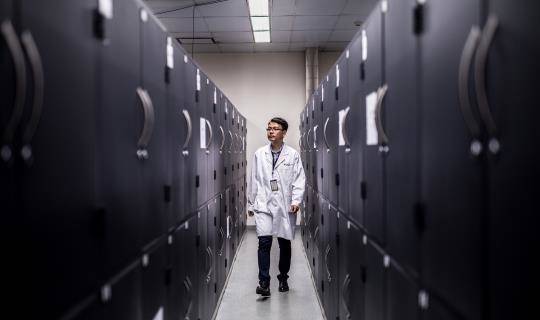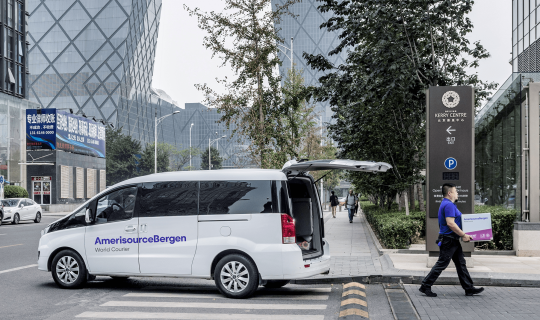Article: The Evolution of Temperature-controlled Transport
By World Courier
This article first appeared on International Pharmaceutical Industry, Autumn 2015.
Not all of the products you need to ship are created equal — and neither is their packaging. Today’s customers require precise processes and innovative tools capable of moving their shipments around the world within an increasingly narrow temperature range. These temperature- controlled packages are part of what we call the “cold chain,” and may include such high-value products as vaccines, biological samples and biologics, drugs with active pharmaceutical ingredients and other products with a strict timeline, including drugs intended for emergency therapy or those with low stability and temperature excursion tolerance.
These factors, and countless others (think stringent customs regulations, worker strikes, loss of power, varying climates, civil disruptions — just to start) can and do lead to shipment delays and dangerous and irregular temperature excursions. That spells serious trouble for a shipment’s integrity, and may often cause a breakdown in patient therapy and adherence, as well as trial delays and ultimately patient loss.
Customers rely on the unsurpassed knowledge and flawless execution of their speciality logistics partners to find effective solutions that will maintain the integrity of their high-value product, carefully manage the temperature of the shipment to within a few degrees, and expedite the shipping process. In fact, it is often in a shipper’s best interest to invest in packaging that can function independently of the supply chain and keeps shipments on-temperature — even when conditions deviate.
Temperature control has evolved significantly over the past 20 years, driven by more stringent global regulations, customer demand for new temperature ranges, emerging markets with extreme temperatures and the growing value of drugs like biologics. Speciality logistics removes the hoping and praying out of cold chain supply by improving packaging and introducing exciting and innovative solutions to keep up with customers’ needs and provide options that fit their budget, from short- lasting polystyrene cases to liquid nitrogen dry shippers, all within the risk management approach required by the regulators. And innovation is a never- ending project: look for new cold chain technology to be introduced this autumn at the 2015 World Courier Biomedical Seminar.
Until then, take a journey to see how cold chain technology has evolved over the past two decades, and how it is adapting to address today’s challenges.
Phase 1: Polystyrene and Polyurethane
In the mid-1990s to early 2000s — what we call the “early days” of temperature-controlled transport for pharmaceutical products — semi- active packaging solutions made from expanded polystyrene and expanded polyurethane ruled the cold supply chain. These simple (but often mighty) insulation systems, often referred to as “styrofoam” or “polystyrene”, come in many sizes and consist of an outer shell of insulating material in a cardboard box and refrigerated or frozen coolants, such as water-based gel packs or dry ice. These packages are validated for a certain time period and shipping range — usually short-haul travel and shipments between +2 ̊C and +8 ̊C.
Polystyrene and polyurethane are commonly used today as an inexpensive option for shipping products short distances, such as between a distribution centre and a treatment site. However, this low-tech solution is not right for every shipment. The packaging often experiences temperature excursions and requires different configurations for “summer” and “winter” climates, making it more susceptible to human error. And finally, polystyrene and polyurethane packaging cannot be reused and must be disposed of at the delivery site, making it a burden on the environment.
Phase 2: Phase Change Materials (PCMs)
As the shipping industry moved into the mid-2000s, customers called for more precise temperature ranges over longer distances. Technology began exploring passive packaging solutions capable of maintaining temperatures as low as -35 ̊C and as high as +25 ̊C, such as rigid outer casings made from plastic or laminated plywood, often featuring aluminum edging or steel corners to prevent contact with the ground; vacuum insulated panels (VIPs) made from foam core and sealed with a tough metallic membrane; and most excitingly, phase change materials — or PCMs.
PCMs quickly became the preferred method for many shippers. The advanced insulation technology proved to be five to seven times more effective than polystyrene and polyurethane, and created reliably stable shipping interiors over long journeys, giving shippers more control, better precision and a better chance of maintaining product integrity.
What makes PCMs different and innovative? Their materials. PCMs are usually made from a salt solution or paraffin wax suspended in bricks, and store and release energy differently than water-filled blocks. PCM panels must be preconditioned in a refrigerator or freezer until they reach the correct temperature to allow the package to ship in range. Then, they are placed into a box typically fitted with vacuum insulated panels and sealed to prevent leakage.
Although PCM technology may seem to be a pricey option, it is far more economical in the long run. PCMs often weigh less than polystyrene, polyurethane and water gel packs combined, meaning lower freight costs. They are more reliable and reduce the risk of shipping delay or wasted product. And finally, PCMs can be disinfected and reused after reaching their destination (although customers may elect to use a single-use panel). Panels must be replaced every so often, however, as they lose effectivity.
And here’s a fun fact: Before technology made improvements in temperature monitoring, PCMs were tested by World Courier teams putting various packaging configurations on the roof of their office in London, England to test the materials’ endurance at absolute external ambient temperatures.
Phase 3: Evaporative Cooling and Liquid Nitrogen Shippers
For a price, today’s shippers can use technology that is more like something from a sci-fi movie than cold supply chain. But make no mistake: These high- tech solutions are revolutionising the way we control temperature in shipping. One of these options is evaporative cooling packaging, a smaller and lighter solution for temperature-controlled packages that need to be kept between +2 ̊C and +8 ̊C. While its smaller size limits the number of products that can use it, it also takes up less space and produces less waste.
The intuitively named evaporative cooling packaging needs no preconditioning. Instead, it commonly features a container of water that, when pierced, evaporates to absorb heat and ool the shipment. The evaporation, when combined with other cooling agents, can help a shipment avoid temperature excursions for two to three days — but may not perform as well in colder climates. And as a particular bonus, this type of packaging can be stored on site with no preconditioning, but caution must be taken to use them within their shelf-life.
Liquid nitrogen is another exciting and viable shipping option, particularly for live samples and biologics. Biologics are drugs made from living tissue, either from animals, plants or microorganisms. Liquid nitrogen makes it possible to ship these samples and others at -196 ̊C, low enough to avoid cell death and extend the sample’s life.
This method comes with a warning label: Liquid nitrogen can be dangerous, and packages traveling at such low temperatures must meet specific IATA guidelines. If a shipper plans to ship their product by air using the liquid nitrogen method, it must be contained in a “dry shipper” — a specially designed vessel with a space specifically for liquid nitrogen, and a dry, porous insert to absorb accidental spills or leaks. The package is protected by an additional casing and monitored using a data logger. Dry shippers are reusable, but must be maintained and replaced regularly.
Shippers may also select a “wet shipper” to ship their product using liquid nitrogen. Wet shippers allow for liquid nitrogen to flow between panels, with no absorbent pad. This method obviously presents a higher risk than dry shippers, and are not allowed on passenger flights — making them the less popular choice for pharmaceutical shippers.
Phase 4: Monitoring
Of course, evolution in cold chain packaging is almost meaningless without tools to ensure a shipment’s integrity. Research shows that most temperature excursions occur within a mile of a shipment’s destination — meaning we need technology capable of monitoring a temperature-controlled shipment from packing through transport, storage and delivery.
Monitoring became more prevalent in the mid-2000s, when high-tech loggers, or monitors, were added to packages to mitigate risk and show real- time temperature excursions throughout a shipment’s journey. New monitors with GPS capabilities can detect when they are in-flight on a plane and turn themselves off automatically, but these types of monitors do not have global approval. These monitors add a greater level of visibility. This is vital to ensure that shipments move through the supply chain without interruptions. In fact, customs officials in Saudi Arabia check temp monitors within a shipment and will refuse customs clearance admission into the country to a shipment showing temperature excursion.
Monitoring technology is improving all the time. For example, developers are currently creating a plastic film that can be added to a box in order to measure its temperature and alert concerned parties if and when temperature excursions occur.
Phase 5: The New Norm
Even as cold chain technology continues to evolve and present us with new and exciting ways to transport temperature- controlled products, PCMs and vacuum insulated panels (VIPs) remain the gold standard of cold chain transport. Although these methods can be more expensive — and require time-consuming preconditioning as well as meticulous planning to mitigate risk of temperature excursion, it’s hard to beat the control, precision and stability they offer. There is a perception that vacuum insulated panel boxes are used to transport critical and temperature-sensitive materials. Therefore, they are sometimes prioritised by customs when it comes to clearance, once they see the clean-sided, sturdy boxes. meaning these shipments may clear through investigative sites much more quickly — resulting in fewer delays, mistakes and waste.
Phase 6: The Future of Temperature Control
Packaging will continue to evolve as drug values soar, customer needs change and regulations become more rigorous. Experts have already predicted a myriad of ongoing innovations, including advancements driven by real- time temperature data as well as more efficient reusable packaging.
While patience is a virtue, evolutions in temperature-controlled packaging and monitoring technology can’t come soon enough for many of us. The current cold chain is far from perfect, and still suffers major deficiencies related to improper temperature control during transport and storage. For example, research shows that in the developing world, up to 25 per cent of vaccines still reach their destination in a degraded state.
Additionally, challenges continue to arise as shipments are sent to new and different locations around the globe. Packaging now needs to be able to withstand significant (and often rapid) changes in climate (think shipping from a hot climate in India to freezing temperatures in China) while maintaining a stable interior temperature.
Phase 7: Finding the Right Partner
Are you feeling a little intimidated? Don’t be. There is no question that selecting the correct packaging for your shipment — while also staying on budget and accounting for as many unforeseen obstacles as possible in order to maintain the integrity of your high-value product — is a tall order. Luckily, you don’t have to do it alone.
Selecting the right specialty logistics provider can mean the difference between a precise delivery and a missed connection, expired product, delayed trial or worse. These trusted partners will help you manage your resources, as well as leverage their experience and unsurpassed knowledge to anticipate issues and select packaging suited to your needs.




